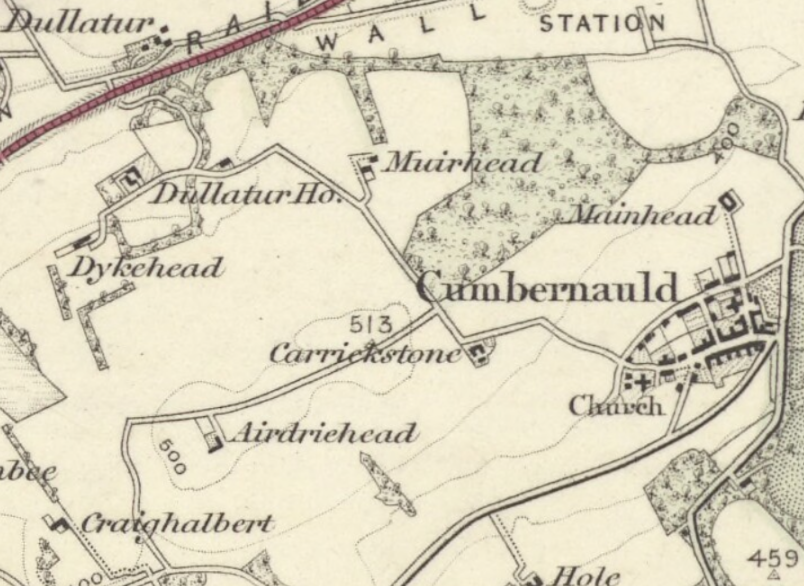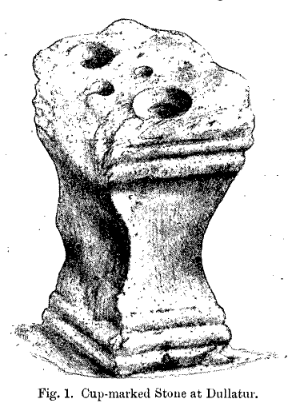The Carrickstone story is intriguing and shrouded in mystery. There are various accounts that relate to its history and whether or not the Stone gave its name to the farm or not.

On early account is found in The New Statistical Account of Scotland published in 1844
“On the farm of Carrickstone or Carrigstone, on the rising ground nearly west of the church, and a little to the south of the Roman wall, there is a large stone, called the Standing-Stone. Though considerably larger than the one above noticed, it is of the same figure, and probably was used for the same purpose, that of an altar. It has no inscription, nor any figure upon it. But it has a hole in it; and tradition says, that this hole received the standard of Robert the Bruce, then Earl of Carrick, who here assembled his army before marching to the field of Bannockburn, 24th June 1314, which decided the independence of Scotland. Supposing this to have been the place appointed for the rendezvous of the army, in a military point of view, Bruce seems to have made a judicious selection. On the north, he had the Dullatur Bog, then a loch or impassable morass; so that, in case of an attack, he had only to defend the narrow defile at the Castlecary on the east, or the narrow valley through the Balloch Bog on the west or southwest ; while, in case of need, he secured for himself a safe retreat, either upon the River Avon and Bathgate to the south-east, or upon the Water of Luggie and the Clyde to the south. This account, it is said, is to be found in some of our early historians.
==
Another account is from Journal published in 1897
NOTES ON A STONE ON THE MOOR NEAR DULLATUR, CALLED THE CARRICK STONE, SHAPED LIKE A ROMAN ALTAR, AND HAVING CUPS ON ITS UPPER SURFACE WITH A DRAWING.
By W. A. DONELLY

The stone, of which a rough sketch is given in fig. 1, stands on a rounded knoll overlooking Dullatur and Cumbernauld, on the line of the old moor road between Glasgow and Stirling, and about 3/4 of a mile to the southward of the line of the Roman Wall. It is known locally as the Carrick Stone, and is also said to have been a Roman altar which its shape certainly suggests, and it has also a legend attached to it that King Robert the Bruce, or someone or other of his campaigns, raised his standard upon it. It is of buff-coloured sandstone, and measures 3 feet 1 inch in height, and 2 feet 4 inches by 1 foot 9 inches in breadth and width upon the top, narrowing considerably in the middle of its height, and again to the expanding bottom. Apart from all conjectures as to its historic associations, the stone seemed to me to be chiefly interesting on account of the cup-markings on its upper surface. It is not a cup and ring-marked stone, but some of its cups have unmistakable ducts leading from them, one of which is very deep. The two larger cups are about 8 inches in diameter and 4 1/2 inches in depth; the two smaller have no ducts, and do not exceed 3 inches in diameter. Most of those who have visited the stone, I believe, regard it as a Roman altar, but I have not been able to find any explanation of the cups upon the top, which are certainly not usual accompaniments of a Roman altar. Could they have been upon the stone before it was made into an altar? Another curious feature is the worn and rubbed appearance of the waist of the altar, as if it had been subjected to powerful friction. It reminded me of nothing so much as one of the old wooden pauls on a pier, the middle part of which had been worn much thinner than the upper and lower parts by the constant friction resulting from the mooring of vessels to it.
“Having been asked whether the stone was called after the farm of Carrickstone, on which it stands, or whether the farm had received its name from the presence of this particular stone, I revisited Dullatur and procured some further information. It seems that the present generation has confused this stone with another which was formerly called the Carrick Stone. The latter was a large slab, which lay horizontally on the ground at the foot of a field about 200 yards in a direct line from the front door of Carrickstone farmhouse, and at the base of the slope of the field. This stone, as described to me, was a rudely dressed slab of freestone, having inscribed on its surface, in large and boldly incised letters, the one word CARRICK, and the local tradition said that it marked the grave of a noted Covenanter who was killed and buried here. In 1857 this stone went the way of so many other relics of the past, and was used in the erection of a modern farm steading on the site of the older Carrickstone farm.”
Mr Donnelly goes on to recount a visit to the farm and after extensive searching was unable to find the stone as described.
Full account here – http://journals.socantscot.org/index.php/psas/article/view/6665/6634
==
The 1841 census records the Millin family as the occupiers.
Farmed by Andrew Millin (40) born 1801.
Agness Millin (35)
Mary Mcfarlan (30) female servant
Jean Allan ( 20) female servant
John Mitchell (18) male servant
John Carmichall (13) male servant
John Millin (10)
Ann Millin (10)
William Millin (5)
Cathrine Millin (1)
In 1865, Carrickstone was leased by the Shaw family from Stand (south of Luggiebank). You can read the full and fascinating story of the Shaw family here.